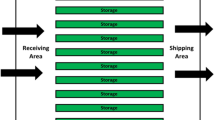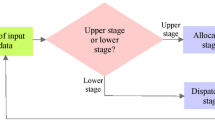Abstract
Line configuration and balancing is to select the type of line and allot a given set of operations as well as machines to a sequence of workstations to realize high-efficiency production. Most of the current researches for machining line configuration and balancing problems are related to dedicated transfer lines with dedicated machine workstations. With growing trends towards great product variety and fluctuations in market demand, dedicated transfer lines are being replaced with flexible machining line composed of identical CNC machines. This paper deals with the line configuration and balancing problem for flexible machining lines. The objective is to assign operations to workstations and find the sequence of execution, specify the number of machines in each workstation while minimizing the line cycle time and total number of machines. This problem is subject to precedence, clustering, accessibility and capacity constraints among the features, operations, setups and workstations. The mathematical model and heuristic algorithm based on feature group strategy and polychromatic sets theory are presented to find an optimal solution. The feature group strategy and polychromatic sets theory are used to establish constraint model. A heuristic operations sequencing and assignment algorithm is given. An industrial case study is carried out, and multiple optimal solutions in different line configurations are obtained. The case studying results show that the solutions with shorter cycle time and higher line balancing rate demonstrate the feasibility and effectiveness of the proposed algorithm. This research proposes a heuristic line configuration and balancing algorithm based on feature group strategy and polychromatic sets theory which is able to provide better solutions while achieving an improvement in computing time.
Similar content being viewed by others
References
SZADKOWSKI J. Critical path concept for multi-tool cutting processes optimization[C]//In Manufacturing Systems Modeling, Management and Control: Proceedings of the IFAC Workshop, Vienna, 1997: 393–398.
DOLGUI A, GUSCHINSKY N, LEVIN G. On problem of optimal design of transfer lines with parallel and sequential operations[C]//Proceedings of the 7th IEEE International Conference on Emerging Technologies and Factory Automation (ETFA’99), Barcelona, Spain, October 18–21, 1999, 1: 329–334.
KOREN Y, SHPITALNI M. Design of reconfigurable manufacturing system[J]. Journal of Manufacturing Systems, 2010, 29(4): 130–141.
DOLGUI A, FINEL B, GUSCHINSKY N, et al. MIP approach to balancing transfer lines with blocks of parallel operations[J]. IIE Transactions, 2006, 38(10): 869–882.
DOLGUI A, IHNATSENKA I. Branch and bound algorithm for a transfer line design problem: Workstations with sequentially activated multi-spindle heads[J]. European Journal of Operational Research, 2009, 197(3): 1197–1132.
DOLGUI A, KOVALEV S, KOVALYOV M Y, et al. Minimizing setup costs in a transfer line design problem with sequential operation processing[J]. International Journal of Production Economics, 2014, 151: 186–194.
BATTIA O, DOLGUI A, GUSCHINSKY N, et al. Integrated configurable equipment selection and line balancing for mass production with serial–parallel machining systems[J]. Engineering Optimization, 2014, 46(10): 1369–1388.
DOU Jianping, DAI Xianzhong, MENG Zhengda, et al. Optimization for single-part flow-line configurations of reconfigurable manufacturing system based on graph theory[J]. Computer Integrated Manufacturing Systems, 2010, 16(1): 81–89. (in Chinese)
DOU Jianping, DAI Xianzhong, LI Jun. Optimization for multi part flow-line configurations of reconfigurable manufacturing systems based on genetic algorithm[J]. Computer Integrated Manufacturing Systems, 2010, 16(71): 1390–1398. (in Chinese)
SAXENA L K, JAIN P K. A model and optimisation approach for reconfigurable manufacturing system[J]. International Journal of Production Research, 2012, 50(12): 3359–3381.
XU Liyun, XU Changfei, DENG Wei, et al. Research on machining line balancing of engine cylinder block based on SA-PSO algorithm[J]. Transactions of the Chinese Society for Agricultural Machinery, 2014, 45(2): 16–21. (in Chinese)
LI Aiping, LU Li, WANG Shihai, et al. Optimization of flexible machining line balancing for complex prismatic parts[J]. Journal of Tongji University (Natural Science), 2015, 43(4): 625–632. (in Chinese)
ESSAFI M, DELORME X, DOLGUI A, et al. A MIP approach for balancing transfer lines with complex industrial constraints[J]. Computers & Industrial Engineering, 2010, 58: 393–400.
ESSAFI M, DELORME X, DOLGUI A. Balancing transfer lines: A two phase heuristic[J]. Studies in Informatics and Control, 2010, 19(3): 243–252.
ESSAFI M, DELORME X, DOLGUI A. Balancing lines with CNC machines: A multi-start ant based heuristic[J]. CIRP Journal of Manufacturing Science and Technology, 2010, 2(3): 176–182.
ESSAFI M, DELORME X, DOLGUI A. A reactive GRASP and path relinking for balancing reconfigurable transfer lines[J]. International Journal of Production Research, 2012, 50(18): 5213–5238.
BORISOVSKY P A, DELORME X, DOLGUI A. Genetic algorithm for balancing reconfigurable machining lines[J]. Computers & Industrial Engineering, 2013, 66: 541–547.
BORISOVSKY P A, DELORME X, DOLGUI A. Balancing reconfigurable machining lines via a set partitioning model. International[J]. Journal of Production Research, 2014, 52(13): 4026–4036.
DAS K, BAKI M F, LI X Y. Optimization of operation and changeover time for production planning and scheduling in a flexible manufacturing system[J]. Computers & Industrial Engineering, 2009, 56: 283–293.
OSMAN H, BAKI M F. Balancing transfer lines using Benders decomposition and ant colony optimization techniques[J]. International Journal of Production Research, 2014, 52(5): 1334–1350.
Author information
Authors and Affiliations
Corresponding author
Additional information
Supported by Shanghai Municipal Science and Technology Commission (Grant No. 12JC1408700), and National Science and Technology Major Project of the Ministry of Science and Technology of China (Grant Nos. 2013ZX04012-071, 2011ZX04015-022)
LIU Xuemei, is currently an associated professor at Tongji University, China. She received her PhD degree from Chongqing University, China, in 2002. Her research interests include intelligent manufacturing system and manufacturing information engineering.
LI Aiping, is currently a professor at Tongji University, China. Her research interests include intelligent manufacturing system and digital design.
CHEN Zurui, is currently a master candidate at School of Mechanical Engineering, Tongji University, China.
Rights and permissions
About this article
Cite this article
Liu, X., Li, A. & Chen, Z. Optimization of line configuration and balancing for flexible machining lines. Chin. J. Mech. Eng. 29, 579–587 (2016). https://doi.org/10.3901/CJME.2016.0203.020
Received:
Revised:
Accepted:
Published:
Issue Date:
DOI: https://doi.org/10.3901/CJME.2016.0203.020




